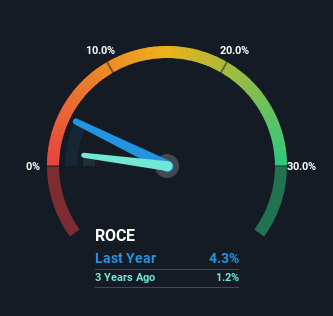- China
- /
- Electrical
- /
- SZSE:002635
Suzhou Anjie Technology's (SZSE:002635) Returns On Capital Not Reflecting Well On The Business

What financial metrics can indicate to us that a company is maturing or even in decline? When we see a declining return on capital employed (ROCE) in conjunction with a declining base of capital employed, that's often how a mature business shows signs of aging. This combination can tell you that not only is the company investing less, it's earning less on what it does invest. So after glancing at the trends within Suzhou Anjie Technology (SZSE:002635), we weren't too hopeful.
What Is Return On Capital Employed (ROCE)?
If you haven't worked with ROCE before, it measures the 'return' (pre-tax profit) a company generates from capital employed in its business. The formula for this calculation on Suzhou Anjie Technology is:
Return on Capital Employed = Earnings Before Interest and Tax (EBIT) ÷ (Total Assets - Current Liabilities)
0.043 = CN¥265m ÷ (CN¥8.3b - CN¥2.2b) (Based on the trailing twelve months to March 2024).
So, Suzhou Anjie Technology has an ROCE of 4.3%. Ultimately, that's a low return and it under-performs the Electrical industry average of 6.0%.
Check out our latest analysis for Suzhou Anjie Technology

In the above chart we have measured Suzhou Anjie Technology's prior ROCE against its prior performance, but the future is arguably more important. If you're interested, you can view the analysts predictions in our free analyst report for Suzhou Anjie Technology .
So How Is Suzhou Anjie Technology's ROCE Trending?
There is reason to be cautious about Suzhou Anjie Technology, given the returns are trending downwards. About five years ago, returns on capital were 7.1%, however they're now substantially lower than that as we saw above. And on the capital employed front, the business is utilizing roughly the same amount of capital as it was back then. Since returns are falling and the business has the same amount of assets employed, this can suggest it's a mature business that hasn't had much growth in the last five years. So because these trends aren't typically conducive to creating a multi-bagger, we wouldn't hold our breath on Suzhou Anjie Technology becoming one if things continue as they have.
While on the subject, we noticed that the ratio of current liabilities to total assets has risen to 26%, which has impacted the ROCE. Without this increase, it's likely that ROCE would be even lower than 4.3%. While the ratio isn't currently too high, it's worth keeping an eye on this because if it gets particularly high, the business could then face some new elements of risk.
Our Take On Suzhou Anjie Technology's ROCE
In the end, the trend of lower returns on the same amount of capital isn't typically an indication that we're looking at a growth stock. In spite of that, the stock has delivered a 31% return to shareholders who held over the last five years. Regardless, we don't like the trends as they are and if they persist, we think you might find better investments elsewhere.
On a final note, we've found 1 warning sign for Suzhou Anjie Technology that we think you should be aware of.
While Suzhou Anjie Technology may not currently earn the highest returns, we've compiled a list of companies that currently earn more than 25% return on equity. Check out this free list here.
New: Manage All Your Stock Portfolios in One Place
We've created the ultimate portfolio companion for stock investors, and it's free.
• Connect an unlimited number of Portfolios and see your total in one currency
• Be alerted to new Warning Signs or Risks via email or mobile
• Track the Fair Value of your stocks
Have feedback on this article? Concerned about the content? Get in touch with us directly. Alternatively, email editorial-team (at) simplywallst.com.
This article by Simply Wall St is general in nature. We provide commentary based on historical data and analyst forecasts only using an unbiased methodology and our articles are not intended to be financial advice. It does not constitute a recommendation to buy or sell any stock, and does not take account of your objectives, or your financial situation. We aim to bring you long-term focused analysis driven by fundamental data. Note that our analysis may not factor in the latest price-sensitive company announcements or qualitative material. Simply Wall St has no position in any stocks mentioned.
Have feedback on this article? Concerned about the content? Get in touch with us directly. Alternatively, email editorial-team@simplywallst.com
About SZSE:002635
Suzhou Anjie Technology
Engages in research and development, production, and sales of precision functional devices, precision structural parts, and module products.
Excellent balance sheet with reasonable growth potential and pays a dividend.
Similar Companies
Market Insights
Community Narratives



